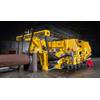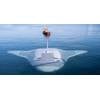Dr. Matthews named 2022 Acoustic Zooplankton Fish Profiler (AZFP) Award Contest Winner

Swarm of adult Chaoborus edulis midges blowing ashore in Nkhata Bay. Photo credit: Joakim Sundstrom.
ASL Environmental Sciences announced Dr. Philip Matthews as the winner of the sixth annual Acoustic Zooplankton Fish Profiler (AZFP) early career scientist award contest. Dr. Matthews is an Associate Professor in the Department of Zoology at the University of British Columbia (UBC) and runs the Comparative Respiratory Physiology and Biomechanics laboratory.
Dr. Matthews will be using a multi-frequency AZFP to understand the physiology and ecology of the deepest diving insect in the world—the Chaoborus edulis of Lake Malawi in southeastern Africa. He will be leading a team of two UBC graduate students, a fisheries research officer from Malawi and a UBC associate professor.
Lake Malawi is recognized as being rich in fish biodiversity with its waters teeming with more fish species than any other lake in the world. This lake is also home to Chaoborus edulis, remarkable Malawian midges that number in the billions and that regularly erupt from the lake surface forming vast twisting clouds that extend hundreds of meters above the lake (see figure). In their aquatic larval stages, this species has an unmatched diel vertical migration of well over 200 m where it dives deep into the lake’s hypoxic zone to escape fish predation during the day and ascends back to the surface at night.
To accomplish this impressive daily vertical migration, Chaoborus edulis larvae control their buoyancy with internal air-filled bladders. The complex mechanisms that govern this process have only recently been discovered through the ground-breaking research carried out by Dr. Matthews’ laboratory. Their work revealed that these midges use a pH-powered mechanochemical engine to regulate their buoyancy.
How deep this species dives, how their air-sacs can function at these depths, and how their daily mass migration influences the distribution of their zooplankton prey and predatory fish are all critical questions which remain unanswered. As the air-sacs present an acoustic target, tracking these migrations with a multi-frequency AZFP combined with a suite of water quality monitoring instruments will begin to reveal how this insect’s unique physiology is shaping the ecology of one of the most biodiverse lakes in the world. In addition, zooplankton net samples of the upper 100 m will be collected to examine the Chaoborus edulis’ physiology.















 February 2024
February 2024



